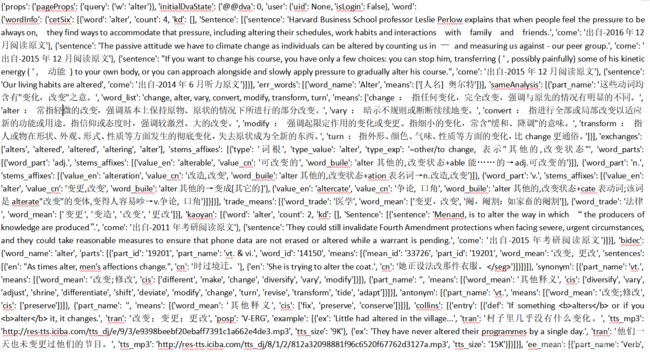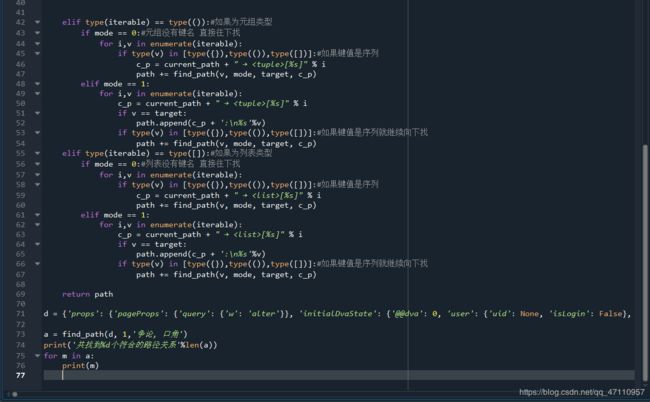python超多层序列找到指定值的路径关系(包括字典列表元组混合的情况)
背景
平时遇到的序列最多套个三层就差不多了,但是最近在爬金山词霸的时候

如上图下面这些例句,后面几个指定意思的例句要爬出来就得找script标签里的东西。但是一找就懵逼了

字典套字典套字典套字典套字典套列表套字典套…数不过来有多少层了一开始想网上随便找个别人写好的找路径代码,但是都是只能单找字典,我这个情况是字典和列表混合嵌套啊。还是自己写一个找路径的代码模块吧emm。也方便以后和我一样找不到能直接拿来用的代码的人
代码效果展示
具体代码
主要是用递归,然后内部会对不同数据类型分类讨论
功能:函数find_path可以返回一个列表,包含所有符合的路径
第一个参数是要进行查找操作的序列;第二个是模式,0是找字典的键名,1是找值字典或者列表元组都行;第三个是目标量;第四个在使用时不用管不用传值,它是为了在递归的时候传入当前正在查找的路径位置用的。
def find_path(iterable, mode, target, current_path=''):
'''
By
----------
CSDN 虚数魔方
Parameters
----------
iterable : dict or list or tuple
The object iterable.
mode : int
You can use 0 or 1. 0 means look up the key name of dict and i means look up the value
target : arbitrary type
Your target for look up.
current_path : string, optional
This parameter is used to run the function and you don't need to give it a value when you use it. The default is ''.
Returns
-------
path : list
This list contains all eligible paths.
'''
path = []
if type(iterable) == type({}):#如果为字典类型
if mode == 0:#查找键名模式
for key in iterable.keys():
c_p = current_path + " → ['%s']" % key
if key == target:
path.append(c_p)
if type(iterable[key]) in [type({}),type(()),type([])]:#如果键值是序列就继续向下找
path += find_path(iterable[key], mode, target, c_p)
elif mode == 1:
for key in iterable.keys():
c_p = current_path + " → ['%s']" %key
if iterable[key] == target:
path.append(c_p)
if type(iterable[key]) in [type({}),type(()),type([])]:#如果键值是序列就继续向下找
path += find_path(iterable[key], mode, target, c_p)
elif type(iterable) == type(()):#如果为元组类型
if mode == 0:#元组没有键名 直接往下找
for i,v in enumerate(iterable):
if type(v) in [type({}),type(()),type([])]:#如果键值是序列
c_p = current_path + " → [%s]" % i
path += find_path(v, mode, target, c_p)
elif mode == 1:
for i,v in enumerate(iterable):
c_p = current_path + " → [%s]" % i
if v == target:
path.append(c_p + ':\n%s'%v)
if type(v) in [type({}),type(()),type([])]:#如果键值是序列就继续向下找
path += find_path(v, mode, target, c_p)
elif type(iterable) == type([]):#如果为列表类型
if mode == 0:#列表没有键名 直接往下找
for i,v in enumerate(iterable):
if type(v) in [type({}),type(()),type([])]:#如果键值是序列
c_p = current_path + " → [%s]"
% i
path += find_path(v, mode, target, c_p)
elif mode == 1:
for i,v in enumerate(iterable):
c_p = current_path + " → [%s]"
% i
if v == target:
path.append(c_p + ':\n%s'%v)
if type(v) in [type({}),type(()),type([])]:#如果键值是序列就继续向下找
path += find_path(v, mode, target, c_p)
return path
//希望这能帮到你


